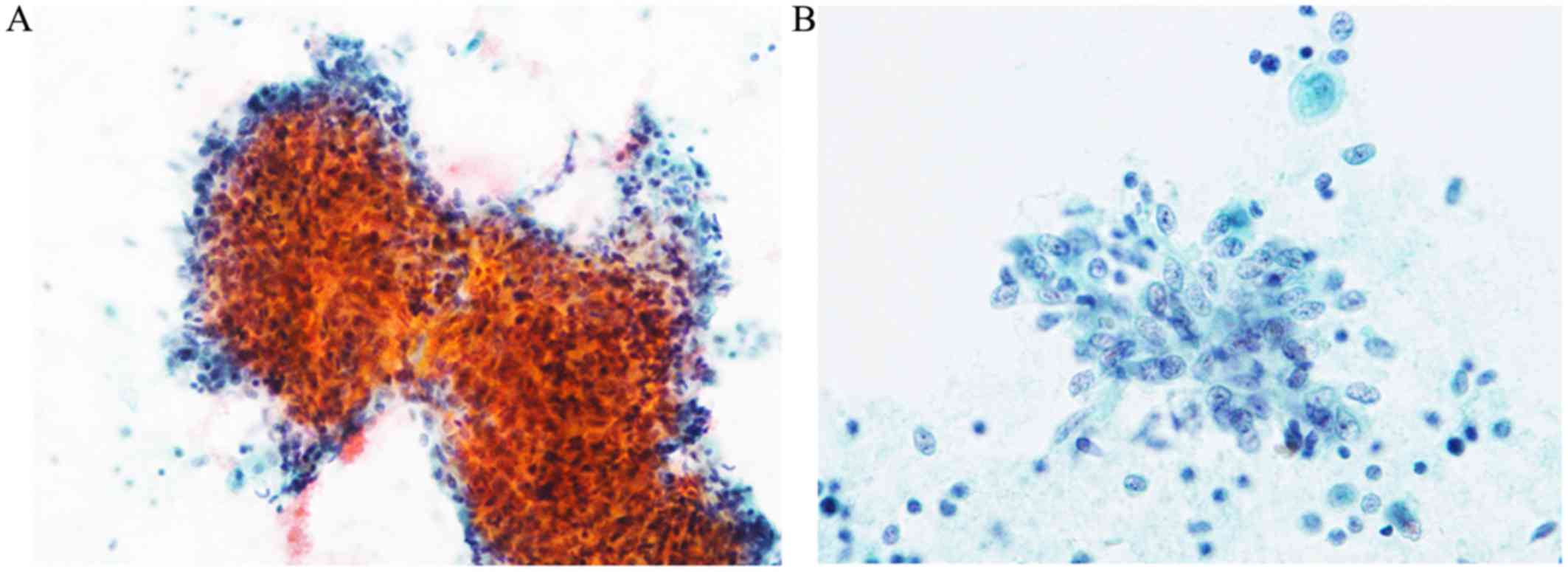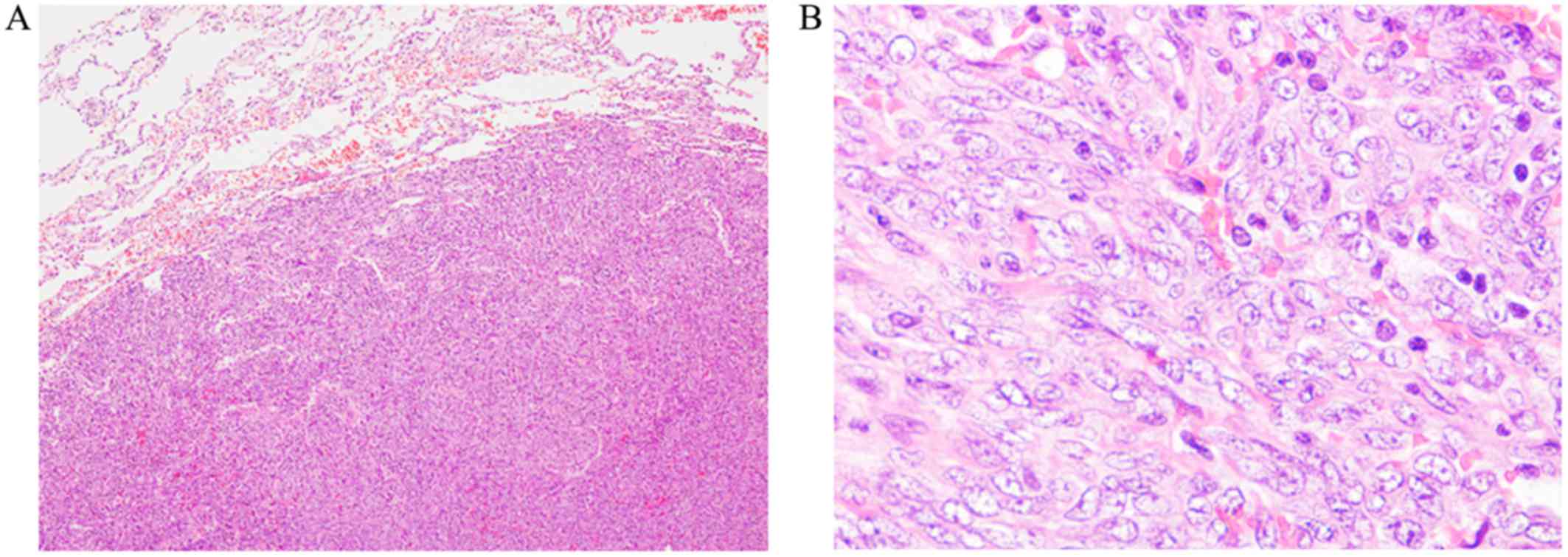Cytological characteristics of meningeal solitary fibrous tumor metastatic to the lung: A case report with immunocytochemical analysis
- Authors:
- Published online on: May 14, 2018 https://doi.org/10.3892/mco.2018.1625
- Pages: 17-20
-
Copyright: © Sandoh et al. This is an open access article distributed under the terms of Creative Commons Attribution License.
Abstract
Introduction
Solitary fibrous tumor (SFT) is a relatively rare mesenchymal tumor. SFT and hemangiopericytoma (HPC) were previously considered to be distinct disease entities; however, the discovery of NAB2-STAT6 gene fusion in the majority of SFT and HPC cases resulted in the recognition of these two entities as a single clinicopathological disease entity referred to as SFT (1,2). SFT can affect virtually any site in the body; however, it occurs preferentially in the pleural cavity. Meningeal SFT is rare, accounting for <1% of all central nervous system tumors (3). This type of tumor occasionally develops extracranial metastases, such as to the lung and liver (3). To the best of our knowledge, this is the first cytological report of primary meningeal SFT metastatic to the lung with an immunocytochemical analysis of signal transducer and activator of transcription 6 (STAT6), with a comparison of the cytological characteristics to those of pleuropulmonary SFT.
Case report
On February 2017, a 58-year-old Japanese male patient was found to have multiple nodules in the bilateral lungs by thoracic computed tomography at Kansai Medical University Hospital 6 years following surgery for right meningeal SFT. Partial resection of the right lung nodules (2 lesions from the upper lobe, and 1 lesion each from the middle and lower lobes) was performed following a clinical diagnosis of metastatic SFT. Touch smears of the lung nodules were performed. Specimens of the tumor touch smears were stained with Papanicolaou stain.
Formalin-fixed and paraffin-embedded specimens of the resected tumors were processed for routine histological examination and immunohistochemical analyses.
In this report, immunohistochemical and immunocytochemical analyses were performed using an autostainer (XT System Benchmark, Roche Diagnostics, Basel, Switzerland, and Autostainer link 48; DAKO Cytomation, Glostrup, Denmark). The primary antibodies used in this report were mouse monoclonal antibody against B-cell lymphoma 2 (Bcl-2; 124), mouse monoclonal antibody against CD34 (QBEnd10), mouse monoclonal antibody against Ki-67 (MIB1) (all from DAKO) and mouse monoclonal antibody against STAT6 (D-1, Santa Cruz Biotechnology, Dallas, TX, USA).
For detection of NAB2-STAT6 fusion, reverse transcription-polymerase chain reaction (RT-PCR) analysis was performed.
Cytological findings of the tumor touch smears
The Papanicolaou smear revealed cohesive hypercellular clusters or sheets of polygonal to elongated neoplastic cells in an inflammatory background (Fig. 1A). These neoplastic cells had scant cytoplasm and oval to short spindle-shaped nuclei with small nucleoli containing coarse chromatin (Fig. 1B). Mild-to-moderate nuclear pleomorphism was observed (Fig. 1B). Neither collagenous stroma nor dilated vascular structures were noted. Mitotic figures were not found.
Immunocytochemical findings
STAT6 was diffusely expressed in the nuclei of the neoplastic cells (Fig. 2). Accordingly, metastatic SFT was suspected.
Histopathological findings
The four resected pulmonary lesions exhibited fundamentally the same characteristics. The tumors were composed of sheet-like proliferations of polygonal to short spindle-shaped neoplastic cells (Fig. 3A). These neoplastic cells had scant cytoplasm and oval to short spindle-shaped nuclei with small nucleoli containing coarse chromatin (Fig. 3B). Slit-like vessels were focally observed; however, fibrous stroma was absent.
A review of the slides revealed that the histopathological characteristics of the meningeal tumor were identical to those of the lung lesions.
Immunohistochemical findings
The neoplastic cells in the lung diffusely expressed STAT6, Bcl-2 and CD34 (Fig. 4). The meningeal tumor displayed the same immunohistochemical characteristics, and the Ki-67 labeling index was 1%. Accordingly, the diagnosis of meningeal SFT metastatic to the lung was confirmed.
RT-PCR
The lung tumor exhibited NAB2ex6-STAT6ex16 fusion.
Discussion
In this article, we described the first cytological report of meningeal SFT metastatic to the lung. The characteristic cytological features of extracranial SFT are as follows: i) Presence of hypercellular clusters, ii) oval, elongated, round, or stellate neoplastic cells with limited nuclear pleomorphism, iii) neoplastic cells with wispy cytoplasm or naked nuclei and iv) presence of pink collagenous intercellular stroma and occasional vessel-like structures (4). In particular, the presence of collagenous intercellular stroma is characteristic for this type of tumor, and this finding is observed in almost all cases of benign SFTs (99.5%) (4). Moreover, it has been reported that cytological characteristics indicative of malignant SFT are the presence of moderate to extensive nuclear pleomorphism, mitotic figures and necrosis (4). In the present case, the presence of hypercellular clusters composed of polygonal to elongated neoplastic cells with scant cytoplasm and oval to short spindle-shaped nuclei corresponded to the above mentioned cytological characteristics. The striking cytological finding in the present case was the absence of collagenous stroma, which is noted in 14% of malignant SFTs, and this makes it difficult to diagnose SFT. Thus, immunocytochemical analysis for STAT6 is required to confirm the diagnosis of SFT (described below).
SFT displays a spectrum of histopathological characteristics. Conventional (typical) SFT exhibits proliferation of spindle cells with scant cytoplasm and uniform oval to spindled nuclei within a prominent fibrous stroma and staghorn vessels. This paucicellular type is classified as fibrous SFT. Tumors with higher cellularity and more rounded cells, but with prominent perivascular fibrosis, are referred to as cellular SFT, whereas highly cellular tumors with well-developed thin-walled or dilated vessels without perivascular fibrosis are classified as HPC (5). Interestingly, Barthelmess et al reported that there is a clinicopathological difference among NAB2-STAT6 fusion variants (5). NAB2ex4-STAT6ex2/3 corresponds to the classical thoracic SFT with fibrous histology and better prognosis. By contrast, NAB2ex6-STAT6ex16/17 represents the cellular SFT and HPC histology, with more aggressive behavior and extrathoracic occurrence (5). Moreover, it has been documented that over half of the cases of meningeal SFT harbor NAB2ex6-STAT6ex16/17 fusion, and the histopathological characteristics also reflect the fusion variant in the meningeal SFT, as well as non-meningeal SFT (6). In the present case, the metastatic tumor harbored NAB2ex6-STAT6ex16 fusion, consistently with the histopathological and cytological characteristics of HPC-type SFT.
STAT6 has been recognized as a useful immunohistochemical marker for both meningeal and non-meningeal SFTs, without regard for fusion variants (5–8). Moreover, the usefulness of the immunocytochemical analysis for STAT6 in formalin-fixed fine-needle aspiration specimens has also been reported (4). In the present case, immunocytochemical staining for STAT6 led to cytodiagnosis of metastatic SFT, although the cytological characteristics were not typical of conventional SFT, including the absence of collagenous stroma. Therefore, immunocytochemical analysis for STAT6 is recommended when SFT is suspected clinically and cytologically.
Acknowledgements
Not applicable.
Funding
No funding was received.
Availability of data and materials
Not applicable.
Authors' contributions
KS, MI and KO contributed to cytological diagnosis and manuscript preparation. YE performed immunocytochemical and immunohistochemical staining. MI and KT performed histopathological diagnosis. KF, TS and TM contributed to patient data collection. TN, KH and CO performed RT-PCR. The final version of the manuscript has been read and approved by all authors.
Ethics approval and consent to participate
Not applicable.
Consent for publication
The authors obtained the consent of the patient to the publication of the case details.
Competing interests
The authors declare that they have no competing interests.
References
|
Chmielecki J, Crago AM, Rosenberg M, O'Connor R, Walker SR, Ambrogio L, Auclair D, McKenna A, Heinrich MC, Frank DA and Meyerson M: Whole-exome sequencing identifies a recurrent NAB2-STAT6 fusion in solitary fibrous tumors. Nat Genet. 45:131–132. 2013. View Article : Google Scholar : PubMed/NCBI | |
|
Robinson DR, Wu YM, Kalyana-Sundaram S, Cao X, Lonigro RJ, Sung YS, Chen CL, Zhang L, Wang R, Su F, et al: Identification of recurrent NAB2-STAT6 gene fusions in solitary fibrous tumor by integrative sequencing. Nat Genet. 45:180–185. 2013. View Article : Google Scholar : PubMed/NCBI | |
|
Giannini C, Rushing EJ, Hainfellner JA, Bouvier C, Figarella-Branger D, von Deimling A, Wesseling P and Antonescu CR: Solitary fibrous tumour/haemangiopericytomaWHO Classification of Tumours of the Central Nervous System. Revised 4th edition. Louis D, Ohgaki H, Wiestler OD and Cavenee WK: IARC; Lyon: pp. 249–254. 2016 | |
|
Tani E, Wejde J, Åström K, Wingmo IL, Larsson O and Haglund F: FNA cytology of solitary fibrous tumors and the diagnostic value of STAT6 immunocytochemistry. Cancer Cytopathol. 126:36–43. 2018. View Article : Google Scholar : PubMed/NCBI | |
|
Barthelmess S, Geddert H, Boltze C, Moskalev EA, Bieg M, Sirbu H, Brors B, Wiemann S, Hartmann A, Agaimy A and Haller F: Solitary fibrous tumors/hemangiopericytomas with different variants of the NAB2-STAT6 gene fusion are characterized by specific histomorphology and distinct clinicopathological features. Am J Pathol. 184:1209–1218. 2014. View Article : Google Scholar : PubMed/NCBI | |
|
Yuzawa S, Nishihara H, Wang L, Tsuda M, Kimura T, Tanino M and Tanaka S: Analysis of NAB2-STAT6 gene fusion in 17 cases of meningeal solitary fibrous tumor/hemangiopericytoma: Review of the literature. Am J Surg Pathol. 40:1031–1040. 2016. View Article : Google Scholar : PubMed/NCBI | |
|
Schweizer L, Koelsche C, Sahm F, Piro RM, Capper D, Reuss DE, Pusch S, Habel A, Meyer J, Göck T, et al: Meningeal hemangiopericytoma and solitary fibrous tumors carry the NAB2-STAT6 fusion and can be diagnosed by nuclear expression of STAT6 protein. Acta Neuropathol. 125:651–658. 2013. View Article : Google Scholar : PubMed/NCBI | |
|
Koelsche C, Schweizer L, Renner M, Warth A, Jones DT, Sahm F, Reuss DE, Capper D, Knösel T, Schulz B, et al: Nuclear relocation of STAT6 reliably predicts NAB2-STAT6 fusion for the diagnosis of solitary fibrous tumour. Histopathology. 65:613–622. 2014. View Article : Google Scholar : PubMed/NCBI |













